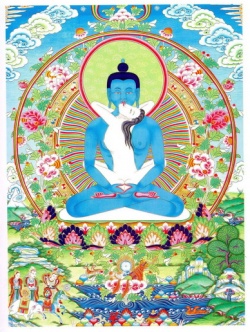Difference between revisions of "The first, or self-existing, buddha"
Jump to navigation
Jump to search
| Line 1: | Line 1: | ||
[[File:Samantabhadra_1456.jpg|thumb|250px|]] | [[File:Samantabhadra_1456.jpg|thumb|250px|]] | ||
| − | '''Adi-Buddha''', among some sects of Mahayana Buddhism, the first, or self-existing, buddha ( | + | '''[[Adi-Buddha]]''', among some sects of [[Mahayana Buddhism]], the first, or self-existing, [[buddha]] (“[[enlightened one]]”), from whom are said to have evolved the five Dhyani-Buddhas. Though the {{Wiki|concept}} of an [[Adi-Buddha]] was never generally popular, a few groups, particularly in [[Nepal]], [[Tibet]], and Java, elevated the Dhyani-Buddha [[Vairochana]] to the position of [[Adi-Buddha]] or named a new [[deity]], such as [[Vajradhara]] or [[Vajrasattva]], as the supreme [[lord]]. The [[Adi-Buddha]] is represented in painting and sculpture as a crowned [[buddha]], dressed in princely garments and wearing the [[traditional]] ornaments of a [[bodhisattva]] (“buddha-to-be”). |
[[Category:Adi-Buddha]] | [[Category:Adi-Buddha]] | ||
Revision as of 17:45, 3 September 2013
Adi-Buddha, among some sects of Mahayana Buddhism, the first, or self-existing, buddha (“enlightened one”), from whom are said to have evolved the five Dhyani-Buddhas. Though the concept of an Adi-Buddha was never generally popular, a few groups, particularly in Nepal, Tibet, and Java, elevated the Dhyani-Buddha Vairochana to the position of Adi-Buddha or named a new deity, such as Vajradhara or Vajrasattva, as the supreme lord. The Adi-Buddha is represented in painting and sculpture as a crowned buddha, dressed in princely garments and wearing the traditional ornaments of a bodhisattva (“buddha-to-be”).
